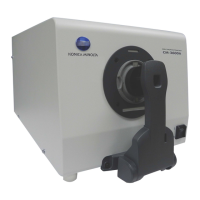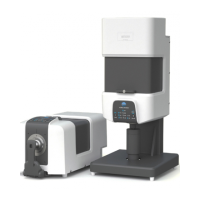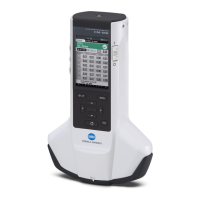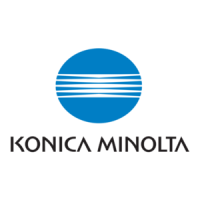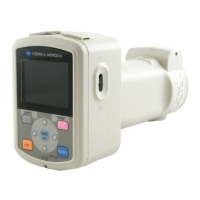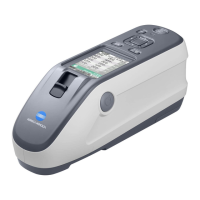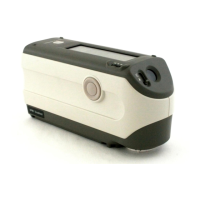18
Performing calibration
Calibration (both zero calibration and white calibration or both 0% calibration and 100% calibration) is effective only
while the Spectrophotometer remains switched on. If it is switched off and then switched on again, both zero calibration
and white calibration (or both 0% calibration and 100% calibration) must be performed before measurements are taken.
c
The calibration becomes effective only when being performed under six kinds of measurement
conditions. Therefore, for example, when performing the measurement of SCI and SCE alternately,
performing the measurement by switching the measurement area in a sequential order, or by switching
the UV light quantity, if you perform zero calibration and white calibration (0% calibration and 100% of
calibration) in advance as to up to six kinds of necessary measurement conditions, you do not have to
perform calibration every time the measurement conditions are changed. However, to more accurately
perform measurement, it is recommended to perform zero calibration and white calibration (0%
calibration and 100% calibration) every time measurement conditions are changed.
c
When the calibration has been performed under the seventh kind of measurement conditions, the oldest
calibration becomes ineffective and the calibration performed under the seventh kind of measurement
conditions becomes effective as the latest. Moreover, when the calibration is re-performed under
the same measurement conditions as one calibration that was already performed, not that the oldest
calibration becomes ineffective, but the calibration already performed under the same measurement
conditions becomes ineffective and the re-performed calibration becomes effective as the latest.
Example) First, zero calibration and white calibration are performed under the following six kinds of
measurement conditions in numerical order.
① Measurement area
:
SAV / Specular component
:
SCI / Target mask
:
SAV / UV light quantity 99.9
② Measurement area
:
MAV / Specular component
:
SCI / Target mask
:
MAV / UV light quantity 99.9
③ Measurement area
:
LAV / Specular component
:
SCI / Target mask
:
LAV / UV light quantity 99.9
④ Measurement area
:
SAV / Specular component
:
SCE
/ Target mask
:
SAV / UV light quantity 99.9
⑤ Measurement area
:
MAV / Specular component
:
SCE
/ Target mask
:
MAV / UV light quantity 99.9
⑥ Measurement area
:
LAV / Specular component
:
SCE
/ Target mask
:
LAV / UV light quantity 99.9
In this case, the calibration can be performed under all the six kinds of measurement conditions. Moreover, the
calibration can be performed when UV light quantity is set except 99.9. However, in this case, the measured
value is calculated and output based on the nearest UV light quantity (in this example 99.9).
Next, if the calibration under the conditions
⑦ Measurement area : SAV / Specular component : SCE / Target mask : SAV / UV light quantity 99.9
is re-performed, not that the oldest calibration under the conditions ① becomes ineffective, but the
calibration under the conditions ④ , which was performed under the same measurement conditions,
becomes ineffective and the calibration under the conditions ⑦ becomes effective as the latest.
Next, if the calibration under the seventh kind of conditions
⑧ Measurement area : MAV / Specular component : SCI / Target mask : MAV / UV light quantity 90.0
is performed, the oldest calibration under the conditions ① becomes ineffective and the calibration under
the conditions ⑧ becomes effective as the latest. As a result, effective calibrations can be arranged in the
following chronological order.
② Measurement area : MAV / Specular component : SCI / Target mask : MAV / UV light quantity 99.9
③ Measurement area : LAV / Specular component : SCI / Target mask : LAV / UV light quantity 99.9
⑤ Measurement area : MAV / Specular component :
SCE
/ Target mask : MAV / UV light quantity 99.9
⑥ Measurement area : LAV / Specular component :
SCE
/ Target mask : LAV / UV light quantity 99.9
⑦ Measurement area : SAV / Specular component :
SCE
/ Target mask : SAV / UV light quantity 99.9
⑧ Measurement area : MAV / Specular component : SCI / Target mask : MAV / UV light quantity 90.0
{
The measured values are affected by UV light quantity to some extent. If you want to perform rigorous
measurement, after changing the UV light quantity, zero calibration and white calibration (0% calibration
and 100% calibration) should be performed. When performing the fluorescent measurement that does
not require rigorous measured values, the measurement should be performed with the UV light quantity
of 99.9.
{
Due to temperature changes in the surrounding environment and heat generation caused by repeated
applications, the indicated values may subtly deviate, but if the calibration is regularly performed, the
measurement accuracy will improve.
